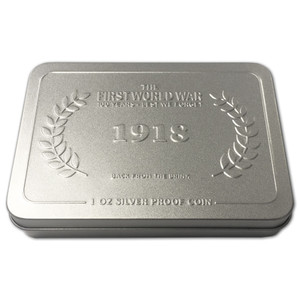1918 Back from the Brink was the fifth and final instalment of New Zealand Post's WW1 stamp and coin programme. It took a look at the final year of this bloody battle, and told the story of the toll it took on the servicemen and how they adapted on their return home.
Issue information
By 1918, the war that had meant to be over and done with by Christmas 1914 was beginning to drain those at home and fighting overseas. With nerves frayed on both sides: those at home jumping at the dreaded knock of the telegraph boy while those on the Western front were running on little more than rations and empty rumours.
The stalemate of the trench warfare was yet to be broken despite the use of technology such as tanks and planes. The only glimmer of light for the allied forces was that America had finally come to the party and was gathering its forces. The Germans were being forced back and losing men they could no longer replace; increasingly things were looking up.
On 11 November 1918 the end of the war was firmly in hand. The Germans signed the Armistice, although formally it was cease fire, everybody knew that the war was finally over. All that remained was to get the weary and fatigued men home, a huge undertaking when many of the 56,000 men were already wounded or mentally traumatised. New Zealand had lost a total 16,700 people during the war, the highest number per capita of the dominions of the British Empire.
The central figure in this year's issue is Arthur Gordon, a heroic solider who lost both of his legs while running a message back to headquarters. On Arthur's return home he learnt to live as normal life as possible with his new prosthetic limbs. Despite his disability, Arthur never let his circumstances get him down, instead he became an advocate for disabled servicemen and made it his goal to procure better treatment for his fellow servicemen.
First Day Cover
New Zealand soldiers could be seen on parade in the French town of Le Quesnoy after they took it back from the Germans. Le Quesnoy had been in the possession of the Germans for the majority of the war. It wasn’t until 4 November 1918 that brave Kiwi soldiers scaled the walls and took the remaining Germans as prisoners.
All ten stamps were available on this collectable cover.
Miniature Sheet First Day Covers
An aerial view of the fortifications of Le Quesnoy was visible beneath the miniature sheet on the four-stamp miniature first day cover. Le Quesnoy was finally liberated from the Germans after a final push from the worn-out Kiwi soldiers overpowered the remaining German forces. The map displayed beneath the six-stamp miniature sheet shows the Order of Battle on the Western Front as of 11am on 11 November 1918.
Miniature Sheets
Each miniature sheet shows a news article or headline from 1918 recounting to the masses at home the success of kiwi troops. While this news wasn't always completely forth coming, towards the end of the war, the incoming communications were increasingly positive.
Commemorative Book
The 1918 Back from the Brink commemorative booklet delved deeply into the final months of the First World War.
It included more details on the fascinating story of Arthur Gordon, from when he left New Zealand in 1916 until his return home in 1920. Far from letting his disability slow him down, Arthur devoted much of his life to advocating on behalf of injured and disabled servicemen.
The booklet also covered the other stamp subjects in more detail, accompanying them with photographs and other images that captured the reality of a war destined to change the world forever.
When you ordered your copy, you learned more about: the Hundred Days Offensive launched in August; the dramatic Kiwi assault on, and recapture of, Le Quesnoy; the arrival of aircraft and their increasingly important role in the war; the long-awaited end to fighting with the signing of the Armistice; the horrors of the influenza pandemic that followed the soldiers home (killing around 8,600 New Zealanders); and the challenging process of demobilisation, rehabilitation and resettlement for the thousands of servicemen who returned.
The Arthur Gordon Story
The Hundred Days Offensive was to be life-changing for Private Arthur Gordon of Tapanui, West Otago. Having enlisted in 1916 and miraculously survived many months of the war without physical injury, he was downed by an enemy shell on 31 August 1918.
Severely wounded in his lower legs, left forearm and neck, Arthur was shipped to a hospital at Walton-on-Thames in England, where one leg was amputated above and one below the knee. During his recovery he slowly learned to walk with the help of a stick – a situation that caused him pain for the rest of his life.
Arthur finally made it to the new family farm at Heriot in February 1920. However, he was unable to farm, so like many of his compatriots and with government support, he chose another profession, retraining as a draughtsman. He also became a passionate advocate for disabled soldiers and a lobbyist to the Government, seeking improvements in everything from the quality of artificial limbs to the rules for war pensions.
Product Listing for 1918 Back from the Brink
| Image | Title | Description | Price |
|---|---|---|---|
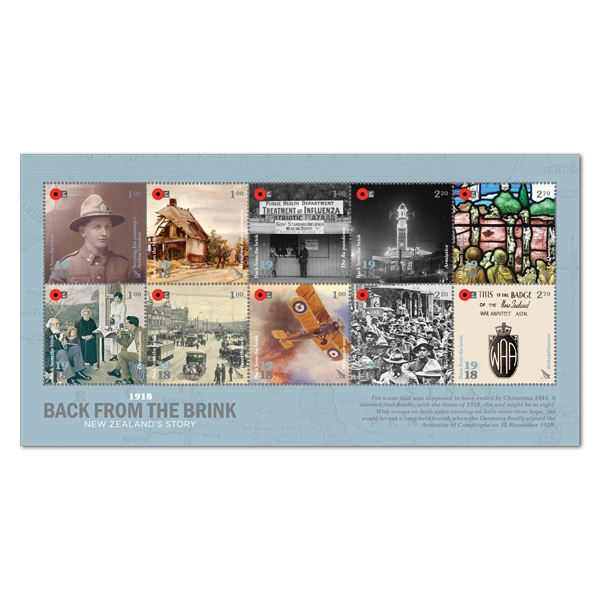 |
Sheetlet |
Mint, used or cancelled sheetlet of ten stamps. The individual stamps in this issue were: Single $1.00 'Arthur Gordon' gummed stamp. Arthur Gordon, the eldest of eight children from a Tapanui farming family, left New Zealand with the 20th Reinforcements in December 1916. He served on the Western Front in the Otago Regiment from June 1917 until suffering life-threatening injuries during the Allies’ Hundred Days Offensive, losing both legs to an enemy shell. Returning to New Zealand in 1920, Arthur spent much of his life as an advocate for injured and disabled soldiers. Single $1.00 'Demobilisation' gummed stamp. The difficulty of returning 56,000 soldiers to New Zealand meant many remained overseas months after the signing of the Armistice. It was also a difficult time for some of those who made it back, particularly the wounded and those affected mentally and emotionally by war. Influenza would also interrupt the demobilisation process, claiming a number of victims living in demobilisation camps at home and overseas. Single $1.00 'Hundred days offensive' gummed stamp. The failure of the German Spring Offensive by July 1918 gave the Allies an opportunity to counter-attack along the length of the Western Front, a strategy that saw rapid advances and liberation of enemy-occupied territory including areas shattered by the previous four years of war. Mobility replaced static trench warfare and by the end of three months the Allies were deep behind the old front lines. Single $1.00 'Resettlement' gummed stamp. The return to civilian life for soldiers was difficult for some. As the number of demobilised men swelled so too did the need for resources to help with their return to work and productivity. More than 12,000 veterans were assisted into homes in the growing towns and cities, while many others chose to work the land, the government supplying loans to those who preferred rural life. Single $1.00 'Flu Pandemic' gummed stamp. An influenza depot in Christchurch, shown here, was one of the many emergency measures taken by the Public Health Department as the pandemic gripped the country at the end of the First World War. Businesses and public places closed up and down the country but military camps and some communities, particularly Māori, suffered while the virus ran its course. Single $1.00 'Great Air War' gummed stamp. Powered flight was barely 10 years old by the time the First World War erupted. It quickly became the focus of rapid technological advances, as each side sought every battlefield advantage. The Sopwith Camel was a welcome sight to New Zealand troops on the Western Front, and many New Zealand pilots served with the Royal Flying Corps, later to become the Royal Air Force, during the war. Single $2.20 'Armistice' gummed stamp. The Armistice of Compiègne, signed by the Allies and Germany on the eleventh hour of the eleventh day of the eleventh month was the agreement that brought the fighting to a close on the Western Front. Although not a surrender by Germany, the Armistice would pave the way for the peace treaty known as the Treaty of Versailles to be signed six months later. Auckland Town Hall is shown here during Peace Festival celebrations that accompanied the Treaty’s signing on 28 June 1919. Single $2.20 'Return of the Pioneer Battalion' gummed stamp. The reluctance of the High Command to allow 'native' troops to occupy Germany meant the New Zealand Pioneer Battalion, made up mainly of Māori and Pacific Islanders, could return home largely as a single unit in April 1919. Their return would serve as a delayed welcome-home celebration for the New Zealand public, with a pōwhiri at Auckland Domain and parade down Queen Street, before a tour down the country. Single $2.70 'Le Quesnoy' gummed stamp. In 1923 St Andrews Church, Cambridge, installed a series of windows commemorating the men of Cambridge killed during the First World War. The last panel of three, partly shown here, depicts New Zealand soldiers scaling the walls of Le Quesnoy on 4 November 1918, one week before the Armistice. Many commemorative windows, statues, and plaques were erected after the war in small towns across New Zealand, many of which had been particularly hard hit by war casualties. Single $2.70 'Rehabilitation' gummed stamp. As soldiers returned to New Zealand with long-term injuries and disabilities, the New Zealand Government responded by dedicating resources, including investing in hospitals and facilities, towards rehabilitation. The War Amputees' Association, established in 1918 at the New Zealand Military Hospital in Surrey, England, was one of a number of independent organisations who also recognised the needs of the injured and disabled. |
$15.80 |
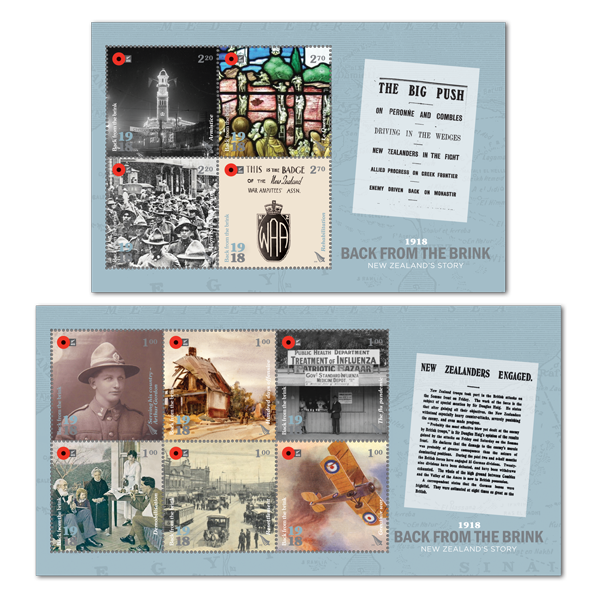 |
Set of Miniature Sheets | Set of two mint, used or cancelled miniature sheets. | $15.80 |
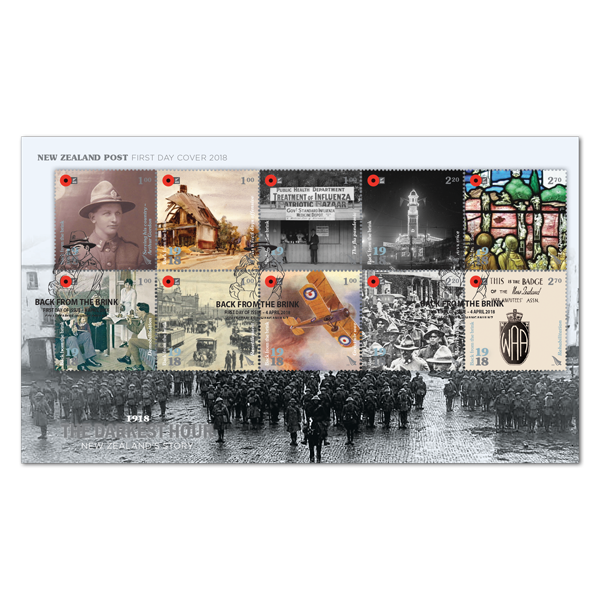 |
First Day Cover | First day cover with ten gummed stamps affixed. Cancelled on the first day of issue. | $16.30 |
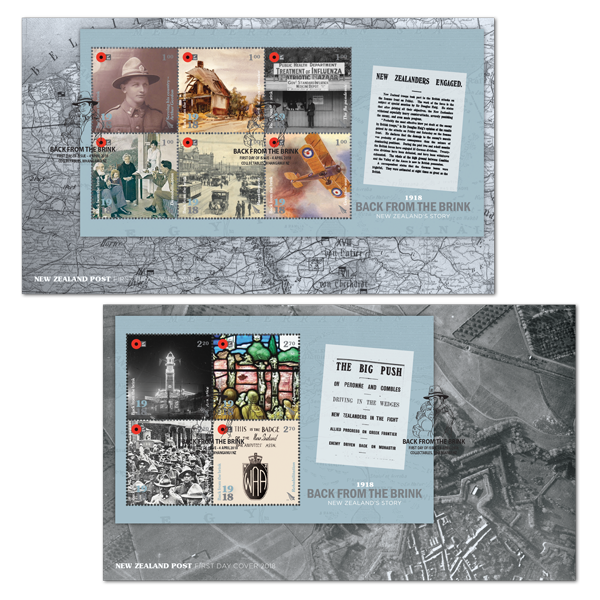 |
Set of Miniature Sheet First Day Covers | Set of two first day covers with gummed miniature sheets affixed. Cancelled on the first day of issue. | $16.80 |
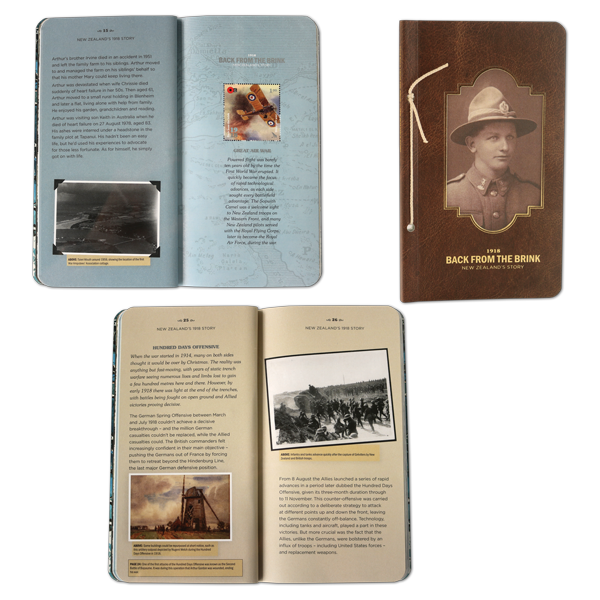 |
Miniature Sheet Booklet |
This year’s booklet, 1918 Back from the Brink, is the fifth and final in the First World War series. The incredible achievements of Arthur Gordon, both while he was on the Western front and upon his return home are gone over in greater detail. From losing his legs to a shell while running messages, to trying to normalise life through work upon his return, it’s clear that Arthur was a courageous and incredible man. The booklet also covers the other stamp subjects in more detail, accompanying them with photographs and other images that capture the reality of a war destined to change the world forever. |
$39.90 |
Technical information
| Date of issue: | 4 April 2018 |
|---|---|
| Number of stamps: | 10 gummed stamps |
| Denominations: | 6 x $1.00, 2 x $2.20, 2 x $2.70 |
| Stamps designed by: | Strategy Creative, Wellington, New Zealand |
| Printer and process: | Southern Colour Print by offset lithography |
| Number of colours: | Four process colours |
| Stamp size and format: | 36.95mm x 37.5mm (horizontal) |
| Paper type: | Tullis Russell 104 gsm gummed stamp paper |
| Number of stamps per sheet: | 24 |
| Perforation gauge: | 14.4 x 14.62 |
| Special blocks: | Plate/imprint blocks could be obtained by purchasing at least six stamps from the $1.20 sheet, and eight stamps from the $2.20 and $2.70 sheets. Barcode blocks were available in both A and B formats. |
| Period of sale: | These stamps remained on sale until 3 April 2019. First day covers remained on sale until 3 June 2018. |


